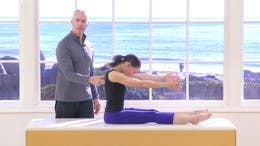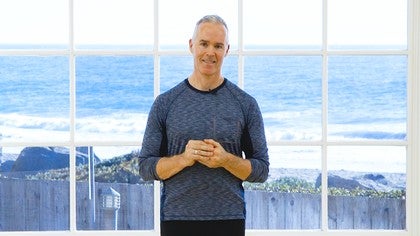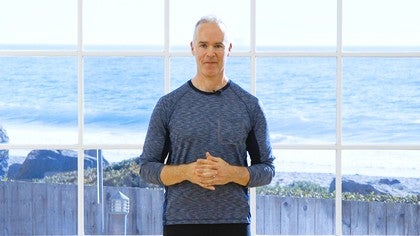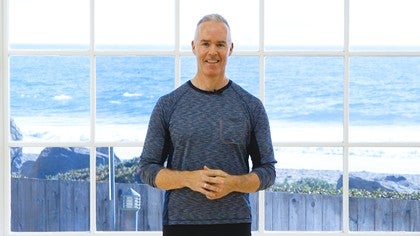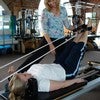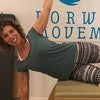Description
About This Video
Transcript
Read Full Transcript
Hi everybody, this is Tom O'Cook, I'm back at PilatesAnytime and this tutorial is on student-centered teaching. How do I make the teaching more about their experience and how they process the information? You know, when we teach, a lot of what we teach is prescriptive. What we're saying is, you know, we're giving them clear directives on what to do and how to do it. And that's all fine and that's necessary.
We have to do that. We have to give them clear directives so they understand the exercise, the position of their body they're in, and then where do I go from there. So student-centered teaching, what's a little different is after you've given the basic nuts and bolts of an exercise, is now help direct their attention and their experience where it's more about what's gonna support the experience they're having which would be by just asking questions. So say I'm doing a roll down for instance and my shoulders are up by my ears. One way you could say what would be prescriptive would be to say drop your shoulders.
So then it's more of a Simon Says thing where the client's gonna go. They're gonna react to you and maybe drop their shoulders. But I found that maybe a better way to go would be would it be possible to do this and not have your shoulders elevated? So now you just gave them a question that they can process and they're gonna inside, they're gonna go are my shoulders up? Yeah, I guess they are.
So you gave them an opportunity to process the information with a little more time, instead of reacting to. And that's what we all need to learn. We need to actually notice what we're doing, process the information of what we're sensing, and then apply what we feel is a better choice. And that's basically what student, in a nutshell, what student-centered teaching is. The other way you can do is you can do what's called error amplification.
So say somebody is rolling down and you're watching them and their weight is shifted over to their left, instead of correcting them, just share with them what you're seeing. It seems like your weight is over on the left side. Okay, I'm noticing that your spine is bending a little bit to the right. Offering no corrections at all, and you're giving the opportunity to sense, because here you are again, you're the external nervous system, giving them feedback that they can't give themselves. So in that way, you're more relaxed.
You're giving them time to process the information in realtime, which is the most vital part of being a teacher, why somebody hires you, I feel, is you're helping them have an experience that they can't have on their own without you there. So you're in realtime offering concrete understanding of what's happening without correcting it. Not that corrections are wrong, but this is just another way where you can give them opportunity to process it safe. And you might notice when they notice they're putting more weight on one foot, their body and their attention, 'cause choice follows awareness, when they become more aware, oh, you're right, my weight is over on the left side, they're probably going to shift more to the center and try to correct their form. Another aspect of self-queuing for your client is who are they?
Why have they come to see you? And what do they want to improve? So if you have a horseback rider, different than a skater, different than a dancer. How about if you get inside of what they're trying to improve, where you keep relating what you're doing to what they've said they want to improve, a lot of times we can assume we know what they want to improve, but if we don't clearly outline that and have them speak that, and then how the exercises are gonna relate to improving what they say they want, their attention might not be as clearly there with you. So if you have them fully understand, now this is gonna really help you when you jump, or when you do whatever it is that you're trying to improve, or it's gonna help you walk, it's gonna help with your back pain.
Now you're relating the why to the how. And that's super important, 'cause you might queue somebody different based on their background, why they came to you, and what they want to achieve. But if we don't ask those questions, we might queue everybody the same, and that's not necessarily as skillful or as useful. In self-queuing terms, when you're watching somebody and you're assessing them, think of your assessment as giving you feedback of what you assume they understand about their body. So if you do some basic body movements of lifting you knees, hinging of the hips, or even asking them to put their fingers on where their legs meet their pelvis, alias their hip joints, I've done that around the world, by the way, with hundreds and hundreds of Pilates teachers, and about 25% actually know where they are.
Not that there's anything wrong with the way they teach, but they haven't been taught. We only do what we know. So if you give people a little bit of understanding of function then you relate it to the lesson, you relate it to the exercise and relate it to their homework, it sticks more. Sticks to their nervous system. They feel the difference.
You just empowered them to do something that's relatively easy that'll help that improve and help themselves. Cause ultimately, everything comes down to self-correction. You want to help somebody help themselves. For me, as a teacher, if my studio blew up and went away, and all my clients moved to a rural place with no Pilates studio, I want to feel like I've taught them something that they can direct their own workout and have a really good experience. In terms of queuing, think of what would be really useful to understand about the body is that you want to mobilize before you stabilize.
And the reason for that is in and around your joints you have all these neuroceptors that give your brain feedback of where you are in space. Proprioceptive feedback. If you don't activate them, it's harder to know where you are. It also helps you release tension and self-correct better, so you want to teach people how to mobilize each area of the body, and I recommend you do it early in their session as part of their warmup. And then include all the plains.
In your spine, you have over 100 joints and they only get lubrication through movement. So a lot of times when the spine is cranky, a little sore, is because a lot of those muscles close to the spine haven't been moved, and it can be an assumption or a jump to mean oh, I got something wrong with my back because my back is sore. Your back might just be saying, please move me. And I kind of lean on that side more than I need to be careful. Because coming into that careful point, another aspect of directing your clients is the mental aspect.
Where you amplify the elephant in the room. If somebody is afraid to move, speak to that. You might even ask to them, why do you say, coming back to the spine, say someone says they're convinced they have a back issue. Why not amplify their thoughts about their spine as their starting place? What do you think about your spine?
Oh, pain, slipped disk. Afraid, discomfort, all of those things. Amplify that, and then you can have the discussion, oh, well, let's move your spine really gently and I'm gonna recite those things to you. My spine is stiff. And then you'll notice the person will probably be inhibited to move.
Then say, okay, let's actually write down what you want for your spine. What are the qualities you want? This is another way of directing them to self-direct. Fluid, spacious, organized, youthful. Now let's do some simple movements and see if that changes your experience.
So that's like a very concrete example of the mental aspect comes down to you focusing on what you want when you're moving. And what qualities do you want? So really simple queues are smooth and fluid. Graceful. These are mood words that people can relate to.
In some ways you'll find it's easier to teach those opposed to anatomical queues. Nothing wrong with anatomical queues, but you want your client to actually understand the anatomy that you're trying to convey in the queue. That would be super useful. But everybody can relate to fluid. Soft, useful, smooth.
Those are really easy terms to relate to. And they up your mood. You can even say joyful, which is really, really nice. So Pilates done well, let's come back to thinking about your muscles for a moment. In terms of queuing.
Pilates done well is eccentric control. So think of your muscles when you move. We all understand you have a couple different types of contraction. You have concentric, eccentric, isometric, when the body just stays still, but there's an activation. So think of in Pilates the way your body moves through space or in good movement is when your muscles are lengthening, they're decelerating your body to protect your joints and control the movement.
So in Pilates, we want to queue people to actually get a sense of that when the movement, when the muscles are lengthening, that they're still active. Also in relationship to student-centered teaching, from a teaching perspective, include a couple key things, which is in every session, teach them about their posture. How they're relating to gravity in each position, whether they're standing, seated, lying prone, supine or even on their side. So you're giving them tactile feedback of where their boney attachments are as far as keeping their head inline with their pelvis and their ribcage, and how things are lining up. That's super useful feedback for your clients, and that's just using touch, and then asking questions so they sense that.
I think you'll find that incredibly valuable for your clients, especially in a lifestyle that we have now, where people spend so much time sitting. So you want to include that in your teaching of their understanding of how to be on their sitbones when they sit. And then relating it to standing and moving well. From the mental aspect again, help your client build their own mental toolbox. Which means, where they learn how to become present, and then direct their attention and then queue themselves in a way that actually helps them have a good experience in whatever you're doing with them.
So one thing you can do with them is start with just having them get still and sense themselves. And a great tool for that is their breathing. So your breathing is a way to bring your attention in, it's also a great tool in any exercise to help you release unnecessary tension. So the breathing is probably one of your most valuable tools that you have. But then like I mentioned earlier, you can use mood words, anatomical queuing, where you're building a little bit of a lesson around the exercise or the function you want to improve with a little bit of backstep of okay, if I'm gonna teach them how to round their spine in a roll down, I might start with the pelvis and show them how the sitbones narrow when they flex their spine, and they widen when they come back up so that you're building a lesson around how the body is designed, and then taking it into the exercise.
So then you're helping them have their own toolbox of how to self-assess themselves and correct themselves when they do exercise or just in life. I hope you've enjoyed this session, and I hope to see you again on PilatesAnytime and keep learning. Thank you, you guys.
The Teacher's Corner: Embrace How You Teach
Comments
You need to be a subscriber to post a comment.
Please Log In or Create an Account to start your free trial.
